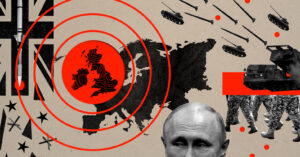The wars in Ukraine and the Middle East have been on many minds recently, not least because neither has been working out the way our politicians and pundits insisted they would. As a result, a genuine revolution in military affairs is now taking place — and no, it’s not the one that was so loudly ballyhooed in intellectual circles a couple of decades back.
During the Nineties, there was much excitement about computer technology opening the way to a new kind of warfare. Information, we were told, would flow from the battlefield to headquarters and back, giving commanders total control over hypercomplex, hugely expensive militaries that would overwhelm more poorly equipped forces with ease. That has, however, not come to pass.
On the battlefields of eastern Ukraine, the single most effective force the Ukrainian army has consisted of little independent units huddled in bunkers just behind the lines, equipped with cheap drones. Right now, Russia has the upper hand by every conventional measure; it has more troops, more tanks, more artillery, more ammunition and other expendables, and a vastly superior air force. Its missiles pound Ukrainian targets hundreds of miles behind the lines — and yet, it is also restricted to slow, gruelling, trench-by-trench advances, because any attempt at a general assault in open country gets chopped to pieces by drones.
The same thing mediated by a different set of technologies is also taking place in the Gaza Strip. The Israeli military is so much larger and better armed than Hamas that, in a conventional struggle, there would be no contest at all. But the Hamas commanders aren’t stupid enough to meet the Israelis in a conventional struggle. Instead, their network of tunnels allows Hamas forces to pop up, ambush Israeli detachments, and vanish again. It’s the same strategy Hezbollah forces in southern Lebanon used against the Israeli army in 2006, and it’s proving just as effective this time around.
Then there’s the Ansarullah militia in Yemen, drawn mostly from the Houthi ethnic group. Their approach to messing with the industrial West is just as cheap and effective. You don’t need a permanent installation to launch a drone against a ship passing through the Red Sea — the back of a truck is quite adequate — and so the US and British forces on the scene have nothing useful to bomb. Yes, some Ansarullah drones get shot down. But so what? It takes a missile costing $2 million to down a drone that only costs $2,000.
The Ansarullah strategy is particularly clever because they don’t have to defeat the US and British navies. All they have to do is make the Red Sea too costly for commercial shipping to Israel and its allies, and they can do that by adding the risk of a drone strike (and the insurance premiums that follow from that risk) to the other costs and dangers shipping companies have to face. If Israel and its allies produced most of their goods and services at home, that wouldn’t be any kind of problem. But it turns out that one of the many downsides to economic globalisation is that it holds every nation’s economy hostage to shipping disruptions in the major sea lanes.
In all three cases, then, what has happened can be described very simply: the spectacularly overpriced armed services of the industrial world have passed their expiry date. They no longer yield military power commensurate with their overwhelming expense: quite the contrary, cheaper ways of fighting wars can now overwhelm them. And as history shows, this is something that happens routinely in the declining years of a civilisation.
The example I have in mind is the battle of Adrianople in 378, when seven Roman legions led by Valens, emperor of the eastern half of the Roman Empire, faced a somewhat smaller force of barbarians led by the Gothic king Fritigern. The Romans lost catastrophically — two-thirds of the Roman force was slaughtered on the battlefield and the rest fled. Valens was among the dead. Before Adrianople, there was still some hope that the Empire could recover from its 4th-century crisis; afterwards, the barbarians had the upper hand and kept it.
There has been a vast amount of speculation about what happened at Adrianople. None of it matters for our present purpose, however. The point that’s relevant is the crucial difference between the two armies that defined the consequences once one of them lost. The difference in question? The cost of fielding an army.
The late Roman military was a sprawling, top-heavy bureaucratic structure divided into many specialised units. Training, equipping, supplying and commanding the ordinary Roman legionary was a complex process demanding huge amounts of money and resources. Much of that cost came from the pervasive corruption and bureaucratisation of late Roman society, in which all economic activity was loaded to breaking point with fees and regulations, and a vast amount of graft also bled every economic sector white. But there was also the simple fact that a complex, specialised, and hierarchically structured army is always going to cost a lot.
The barbarian force, by contrast, wasn’t even an army. Instead, it comprised all the able-bodied men of a couple of Gothic tribes and a few other allied barbarian peoples. Every “soldier” provided his own weapons and armour, and had learned how to use them as a child. They were flexible and resilient precisely because it was unspecialised.
The Roman army was appallingly brittle by contrast. Until Adrianople, the tremendous costs of maintaining the military had been met by raising taxes to sky-high levels, But by 378, the tax burden in the empire was so crushing that economic activity was breaking down under the strain. Thus the destruction of two-thirds of Valens’s army, and an even larger fraction of its officers and staff, was a financial blow from which Rome never really recovered. The barbarians didn’t have that problem, because Fritigern didn’t have to raise money to train, equip, pay and manage his force — he just had to lead it to plunder and be reasonably successful as a general. This was well within his abilities, and equally within the reach of later barbarian kings. The fall of Rome followed in just under a century.
We haven’t yet had an equivalent of the battle of Adrianople. The fighting in Ukraine and the Middle East echoes the struggles of the decades before Adrianople, when Roman politicians and military officers could still convince themselves that the military machine they had inherited from their ancestors was still the most powerful in the world. The US military is in that condition now, lumbering around the planet with its aircraft carriers and high-tech weapons systems, flailing helplessly at drone strikes and trying to pretend that the carnage in Ukraine and the Gaza Strip hasn’t just shown that the entire American way of war is hopelessly obsolete.
There is, of course, an alternative to Adrianople. The United States could withdraw its troops from the 100-odd foreign countries where it has military bases, focus on defending its own borders, and retool its military to adapt to the ongoing revolution in military affairs. That would, among other things, save billions of dollars a year. Yet given the billions would no longer be flowing into the pockets of defence corporations, with a good bit sticking to various fingers on the way, such a change would sure be unpopular with a number of powerful individuals, and probably won’t get put into place until some ghastly military debacle or other forces it. Still, the option’s worth mentioning.
One way or another, however, over the next half century, the massive military forces and hugely expensive defence technologies that have ruled the world’s battlefields since 1939 will be replaced by leaner, less expensive, and less centralised forces. Then that process will go further — propelled forward by two principal compulsions.
The first of those forces is the economic impact of resource depletion. Today’s high-tech weapons systems require fantastically complex and precise inputs of energy and materials, many of which have to be sourced from abroad and then processed in extraordinarily complex ways. Consider the microprocessors that make an ordinary drone capable of doing its job. Silicon is one of the most common elements in the earth’s crust, but silicon pure enough to make into computer chips has to be refined at considerable cost, and then doped with monoatomic layers of rare-earth elements and etched in almost unimaginably fine patterns. Huge factories full of expensive gear, using gargantuan amounts of energy and an equally huge list of raw materials have to be built, powered and maintained so that microprocessors can be produced.
So complex a system won’t be sustainable indefinitely. More to the point, so complex a system won’t be affordable indefinitely. As easily accessible deposits of the raw materials get used up, the price of chips will rise. Rising energy costs will have the same effect, and as microprocessors get more expensive, the economies of scale that briefly made them cheap will work in reverse, and simpler technologies will outcompete them. If it costs less to hire a file clerk than it does to buy and operate a computer, most businesses will hire the file clerk — and as this same equation works through society as a whole, the economic basis for computer industries will shrivel away.
That’s one factor. The other, closely related to it, is the economic impact of population decline. Today, every continent but Africa is producing children at a rate too slow to sustain its current population, and African population curves are moving in the same direction. There’s still a little population increase in the pipeline, in the form of young people who haven’t yet reached reproductive age, but sometime in the next decade or two, the earth will reach its peak human population and begin to see sustained demographic contraction.
Next to nobody seems to have thought through what this implies. Economic growth depends ultimately on population growth; it’s because nobody alive today has ever experienced sustained demographic contraction that we all assume as a matter of course that businesses will increase their sales, real estate prices will go up, and investments will earn profits. In an era of population contraction, none of this is true. Once demographic decline sets in, each business will on average have fewer customers than the year before, each property will have fewer people to bid on it, each investment vehicle will have fewer people investing in it. Thus, the average business, the average asset, and the average investment vehicle will all lose money.
This is one of the unnoticed factors driving the decline of civilisations. If businesses, assets, and investments yield losses rather than profits, few people will be interested in owning them, and economic activity will contract even faster than the population. You can see this dynamic play out in the history of every falling civilisation. A radical simplification of the economy sets in. Market-based economies collapse and are replaced by customary economies, in which money drops out of use and the basis for economic activity is a handful of productive assets that meet real human needs: above all else, farmland capable of raising food crops.
All this makes a convoluted military establishment impossible to sustain. That’s why feudalism is the default setting for human society after the collapse of complex societies. In a feudal system, productive farmland is parcelled out among local warlords, who pass it on to their vassals in exchange for military service. It’s the same system Fritigern knew, adapted to the needs of a settled population: every able-bodied man in a feudal society is a warrior, and can expect to be called out to defend his village from the warriors of rival communities at any moment. It’s only when a feudal system becomes decadent that peasants no longer fight in the infantry.
Some similar system is likely to play a significant role in the deindustrial age. It won’t be identical to the feudal systems of the last 3,000 years, though, for a simple reason: those systems were all shaped profoundly by the revolution in military affairs that followed the domestication of the horse by Indo-European tribes on the sweeping plains where Russian and Ukrainian troops are currently doing battle. From that point on, the feudal aristocrat was a master of horses — on a chariot early on, before horses had been bred large enough to carry riders in battle, and mounted on horseback thereafter. That gave warlords immense advantages over the people they ruled, resulting in a deep schism dividing society into noble and peasant classes.
That age is over, because a different revolution in military affairs swept the planet in the 16th century. During this period, gunpowder became as overwhelming a force in military affairs as horses were, not least because an armoured warrior on horseback is dead meat in a pitched battle involving firearms; a spray of bullets fired by half-trained peasants can easily kill his horse and punch holes in his armour. That’s why cavalry after the 16th century ended up repurposed as a force for scouting and raiding, while infantry took over the hard work of winning pitched battles. It’s also why aristocrats turned into a disposable commodity in most societies.
Yes, archery can also limit the effectiveness of cavalry — the French found that out the hard way at Crecy and Agincourt — but it takes many years of practice to master the longbow, and even so, it’s not as lethal as a gun. An untrained recruit can learn to use a firearm effectively in a matter of weeks. Firearms are also no great challenge to make with hand tools; the famous Kentucky rifle of the early American frontier was made by hand. Doubtless famous gunsmiths in the deindustrial future will be just as legendary as famous swordsmiths in the past, but most guns in the future will be turned out by ordinary craftspeople, just as most swords were back in the day.
With this in mind, it’s not hard to glimpse the warriors of the deindustrial dark ages 400 years from now. They’ll be armed with guns, probably semiautomatic rifles like the ones carried in the two World Wars — and if they have any armour, it’ll be steel helmets. Some of them will ride horses, but most won’t, for the reasons just described. They’ll be a good deal less subservient to the local warlord than their equivalents 1,000 years previously, because of the equalising effect of firearms. But they’ll doubtless have some version of the classic feudal ethic of loyalty and courage to guide them in the rough-and-tumble of an age of chaos.
They may have some unexpected technologies to help them out. Shortwave radios aren’t hard to make by hand — there’s a whole subculture of amateur radio enthusiasts these days who make their own vacuum tubes from mason jars and the like — and having the ability to communicate at a distance is worth an extra army in wartime. It’s also far from impossible that ultralight aircraft made of wood and fabric, powered by alcohol-burning engines will be available in at least a few of the more prosperous areas for aerial scouting. (Larger and more complex aircraft will probably be off-limits for centuries due to hard limits on resources.)
Thus, I imagine an army on the march somewhere in the Ohio valley in 2400 or so, a long column of infantry with little detachments of cavalry scouting ahead and on the flanks, using bulky but functional radios to keep in touch with their commanders, while a couple of ultralights circle overhead to scout at a greater distance. There will doubtless be cannon drawn by horses in the column, too, and just possibly a few simple machine guns as well, but most of the fighting power will consist of young men shouldering rifles. Aside from a few bits of technology, it’s not that different from the armies that marched through that same region six centuries earlier.
That’s the army of a relatively large and stable dark age state, of course. Far more common will be smaller and poorer communities, in which warfare is carried out by relatively small groups of young men without the benefit of cavalry, canon or ultralight planes. In mountainous areas they’ll be all but unconquerable — firearms make guerrilla warfare far more powerful than other weapons systems — so we can expect the political structures of the deindustrial dark ages to feature relatively large states in the lowland river basins and small, defiantly independent communities up in the hills. It’s an old song, given new verses by gunpowder.
Naval power, however, is another matter. Wooden ships became instantly obsolete once explosive shells replaced solid shot in naval cannon, but steel armour in any quantity is only an option if you’ve got ample supplies of cheap coal to turn into coke; our descendants won’t have that. (For the same reason, they won’t have railroads, since you can’t make steel in sufficient volume for rails without coke, and we’re burning the last scraps of the necessary coal reserves right now.) Since shells aren’t difficult to make, and rockets with explosive warheads are even easier, naval flteets of any size may be a thing of the past until some other form of naval armour becomes possible. Piracy will doubtless flourish on the high seas of the deindustrial future, and it will be very hard for maritime nations to control it the way the British navy did.
And beyond the deindustrial dark ages? That’s impossible to predict, because the successor cultures that build on our ruins will have their own ideals, goals, and dreams, which will not be ours. They will favour some technologies and reject others for reasons we can’t anticipate and probably can’t even understand. Our civilisation invented clockwork and steam power and used them to reshape the planet, while the Roman world also invented both these things and did essentially nothing with them. Why? Because there is no one route to the future. Every civilisation follows its own path, and what we call “progress” is simply the temporary trajectory that our civilisation took in pursuit of its dreams.
That trajectory is winding up around us right now, having gone as far as it can. It’s a safe bet that future civilisations will choose their own paths instead. What goals they will seek, and how those will shape their ways of making war, we cannot know.
Disclaimer
Some of the posts we share are controversial and we do not necessarily agree with them in the whole extend. Sometimes we agree with the content or part of it but we do not agree with the narration or language. Nevertheless we find them somehow interesting, valuable and/or informative or we share them, because we strongly believe in freedom of speech, free press and journalism. We strongly encourage you to have a critical approach to all the content, do your own research and analysis to build your own opinion.
We would be glad to have your feedback.
Source: UnHerd Read the original article here: https://unherd.com/





